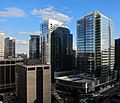LEED facts for kids
Leadership in Energy and Environmental Design (LEED) is a certification program for the design, construction and operation of high performance green buildings since 2002. This mark of excellence is known across the world and there are four levels of excellence. There are 100 possible base points distributed across five major credit categories: Sustainable Sites, Water Efficiency, Energy and Atmosphere, Materials and Resources, Indoor Environmental Quality, plus an additional six points for Innovation in Design and an additional four points for Regional Priority. Buildings can qualify for four levels of certification.
LEED is not a standard but an evaluation grid. LEED is a way to think up and realise art projects in a durable way. LEED only applies to buildings and not to products. It is not a prize but a certification that is delivered by the CaGBC (Canada Green Building Consil). They are the ones who will make sure that all the points are well applied and respected.
So, LEED is a grid that helps us obtain a maximum gain of money, health conditions and restrictions on earth pollution. If there is a house to build in Canada, we must do the excavation and that earth is usually brought to a landfill. But, if you want to stay within LEED standards, that earth must be left on the site. Also, if you have to demolish a building, you must use and demonstrate that you recycled all materials in the construction. Also, that you used the maximum quantity of material possible from the old building to the one being built.
Certification
| Certification | Points | |
|---|---|---|
| Silver | 40–49 points | |
| Gold | 60–79 points | |
| Platinum | 80 points and above |
Certified: 40–49 points, Silver: 50–59 points, Gold: 60–79 points, Platinum: 80 points and above
Benefits and disadvantages
There are several benefits but there are also disadvantages. The biggest disadvantage is the amount of money it takes to start a project. At first, it may seem expensive. If you look at it as a long term investment, though, a LEED project can save a good amount of money.
A 2008 white paper by the Leonardo Academy compared LEED-EB buildings to data from BOMA's Experience Exchange Report in 2007. This showed that LEED-EB certified buildings had better operating cost savings, in 63% of the buildings surveyed. It ranged from $4.94 to $15.59 per square foot of floor space, with an average valuation of $6.68 and a median valuation of $6.07.
Images for kids
-
Washington, D.C., is the first LEED Platinum city in the world. Pictured is 1225 Connecticut Avenue, the first redeveloped office building on the U.S. East Coast to receive LEED Platinum status.
-
Arlington County, Virginia, is the first LEED Platinum community in the world. Pictured is 1812 N Moore, the tallest LEED Platinum building in the Washington metropolitan area, and other towers of various LEED status.
-
Phipps Conservatory & Botanical Gardens in Pittsburgh has multiple LEED certifications, including the world's only Platinum-certified greenhouse and a Platinum-certified and net-zero energy Center for Sustainable Landscapes.
-
The University of Texas at Dallas Student Services Building is the first academic building in Texas to receive LEED Platinum status.
-
Shearer's Foods plant in Massillon, Ohio, is the first food manufacturing plant to receive LEED Platinum status.
-
Shanghai Tower, the tallest and largest LEED Platinum certified building in the world since 2015.
-
The Empire State Building in New York City is one of the tallest and most well-known LEED-certified buildings, certified as an existing building.
See also
 In Spanish: Liderazgo en Energía y Diseño Ambiental para niños
In Spanish: Liderazgo en Energía y Diseño Ambiental para niños











